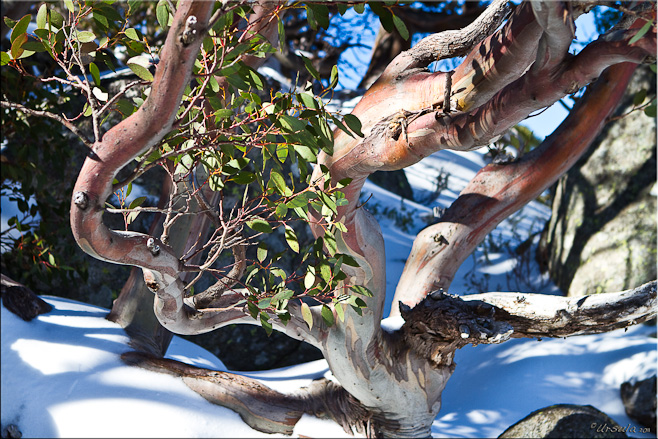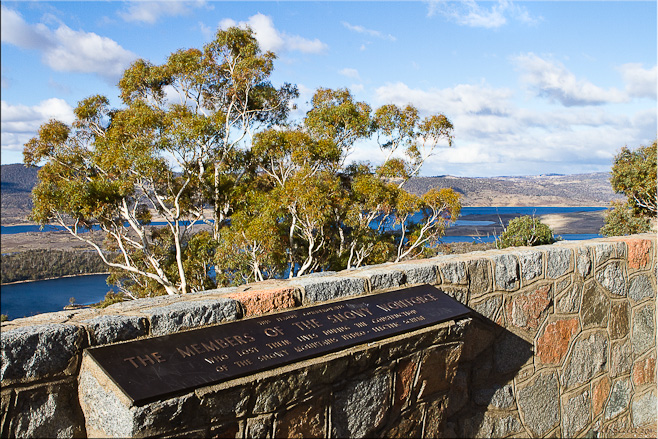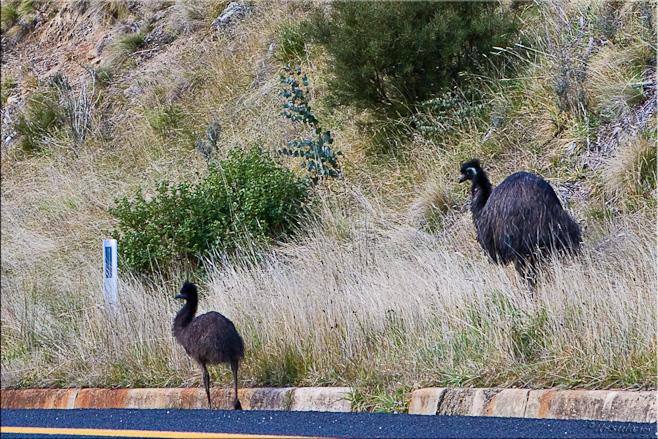
Twisted Snow Gum (Eucalyptus pauciflora) in a Bed of Snow ~ Charlotte's Pass
The snows came early this year.
It was only mid-May, and already the tops of the Australian Alps were covered with white. Even down in Jindabyne (934 metres) where we were staying, wet flakes settled briefly on our noses before puddling into cold water. Late one afternoon we tried to drive up to Charlotte Pass, at the top of Kosciuszko Road, only to be turned back by a nice National Parks employee who laughed at our Queensland-plated rental car and asked us where our snow chains were. We had to be satisfied with a view-stop at the Waste Point Lookout and a drive up to Threadbo, where, in spite of grey skies and light flurries, the road was still open.

Against the Backdrop of Lake Jindabyne, at the Waste Point Lookout, is a Plaque Commemorating the Workers who Lost Lives Building the Snowy Hydro-Electric Scheme

Junior and Senior Emu (Dromaius novaehollandiae), Alpine Way, NSW
We had tried to get snow chains, but winter rentals are a seasonal business, and with the ski season not due to open for another three or four weeks, none of the rental shops were operating. Snows fell in the Australian Alps in April this year, which is unseasonably early – although snow can fall any time from May to October, significant falls before June (when the ski season usually opens) are unusual. Australia is a relatively flat, dry continent with the alpine area comprising a minute (about 0.15%) proportion of the total landmass. The country’s highest point, Mount Kosciuszko, at 2228 meters, has a bare peak in summer, and the alpine area only hangs onto the smallest patches of snow, tucked into shady hollows, between winters.

Through the Windscreen and into the Snowy Mountains
The next morning we tried again and this time succeeded, albeit slowly and carefully, in making it up through the slush, snow and ice to Charlotte Pass and the fabulously gnarled snow gums that line the aptly named Snow Gums Boardwalk.
Snow Gums (Eucalyptus pauciflora) are amazing trees. Living between 1500m and the tree line, they have adapted themselves to the extreme conditions of the alpine slopes. Curled against the wind, the snow gums have a bark that changes colour in response to climactic conditions and external branches that slope down to allow the snow to fall off. As one writer puts it: “it is their twisted shapes that makes you stand in awe and feel humbled, moved, and inspired by their resilience and determination”.

A Colourful Snow Gum

The Smooth Pale Bark of the Snow Gum Peels in Patches ~ The Colours Change with the Barometric Pressure

The Red Bark of a Snow Gum Stands in Contrast Against Snowy Mt Townsend

Snow Gums and Mountains ~ The Road at Charlotte Pass

The Last Grasses

Like Other Kosciuszko Shrubs, Fragrant Mountain Mint Withstands Being Buried Every Year

Spencers Creek and the Mountains

Still Life ~ Stone and Snow
The plants and animals that live here, many of which live nowhere else, are well adapted to the snowy conditions. They are, however, vulnerable to the already-measurable effects of climate change, and it is likely that the next decades will see significantly changes in this unique landscape.

Ice and Snow, Spencers Creek

Afternoon Light, Spencers Creek

Many species will probably be lost entirely within our lifetime.
It’s a shame, isn’t it?
Until next time…

















.jpg)


Great stuff Ursula. That Snow Gum bark is amazing, such wonderful texture and colours.
Thanks for stopping in, ฝรั่ง. Yes – Snow Gums are amazing trees. 😀
this is a trip I can make, and should… the tragedy that some of these amazing species could be lost in such a short period of time when we still have pollies discussing whether or not climate change is valid is awful, or unbelieveable depending on where you stand on the matter… they say that the koala is on borrowed time, between disease, climate changes and habitat loss we really do need to STOP…THINK… ACT…before it’s too late.
thanks for the share, those gums are magic!
Hi Signe!
I never quite understand how there can be a debate, except regarding the extent of the impact. Published government documents are quite clear:
http://www.australianalps.environment.gov.au/nature/conservation.html and http://www.australianalps.environment.gov.au/publications/general/pubs/climate.pdf
Thanks for stopping by! U.
[…] That is one of the reasons why I like to get away to the Australian Alps. […]